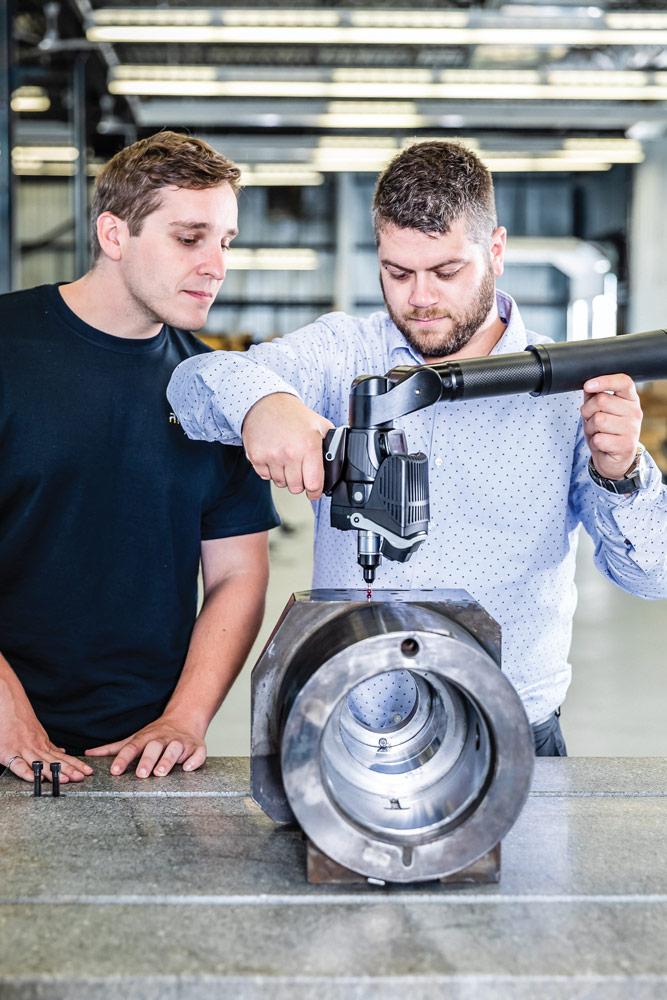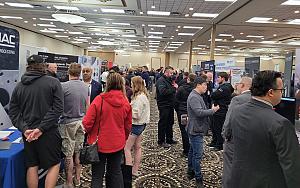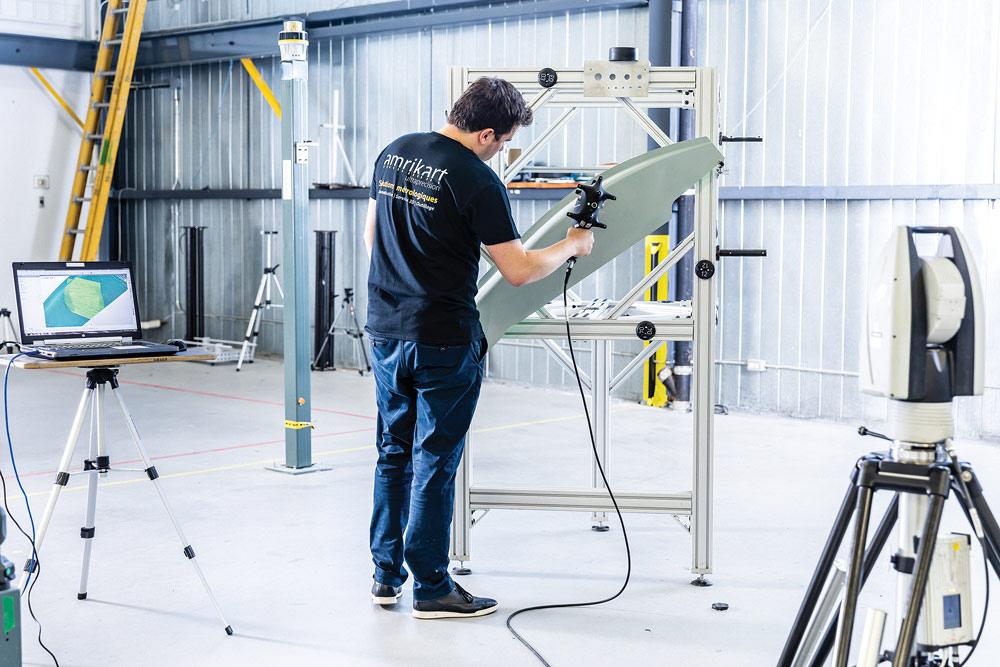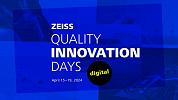Directeur Général
- FMA
- The Fabricator
- FABTECH
- Canadian Metalworking
Do you need a metrologist or a metrology instrument operator?
How do you measure up?
- By Jérémy Arpin-Pont
- June 14, 2021
- Article
- Measurement
It’s a question asked in every quality department: Do I need a metrologist or is our work better suited to a metrology instrument operator?
The answer may seem obvious, but for many the distinction between a metrologist and someone who operates a laser tracker, CMM, or 3D scanner can be hard to grasp. The “International Vocabulary of Metrology,” a guidance document from Bureau International des Poids et Mesures (BIPM), defines metrology as the science of measurement and its application and a metrologist as a specialist who masters the science of measurement and its application. An instrument operator, on the other hand, is a person who operates equipment or a machine.
The Measurement Process
To understand the difference, let’s have a look at a typical five-step measurement process:
- Requirements evaluation
- Methods determination
- Measurement
- Data processing
- Analysis
The quality of resulting information -- the measurement results -- depends on decisions made at each step of the process. The metrologist takes ownership of the whole measurement process, while the instrument operator specializes only in taking measurements with the necessary instruments (step No. 3).
The metrologist typically is a professional engineer or a specialized technician with several years of experience in the field. A thorough understanding of the measurement project is essential to assess its requirements, define methods, guide measurement taking, process the data, and perform the analysis. The analysis will produce the information that leads to crucial decision-making.
Metrologists have a very substantial influence on the resulting information because they oversee the whole process. They are required to ensure that the resulting information meets any needed requirements. They also are required to be aware of the field limitations and need to master the best practices.
Field limitations are what is possible to do in terms of measurement and accuracy with the actual technology and methods that are available. For example, metrologists need to be aware that it is impossible to measure a 100-ft.-long part within an accuracy of a few thousandths of an inch without controlling environmental conditions (temperature).
Limitations also are defined by the standards we use for the measurements and interpretations. For example, in the ASME Y14.5 standard for geometric dimensioning & tolerancing (GD&T), flatness is supposed to be measured on the entire surface of a plane but this can only be done with a high-density 3D scan. If we use a CMM with a probe, we measure only a small number of points on the plane, and assume they are representative of the whole surface. But if there is a bump somewhere, it is possible we won’t measure it. That is, for example, a limitation of probing.
Alternatively, an instrument operator is a professional that masters the equipment’s functions and operates it to take high-quality measurements.
Typically, the instrument operator has a specialized technician degree and often works within a production line or quality assurance department. The instrument operator follows specific instructions to conduct the measurements, generating raw metrology data by following a predefined method. With training and experience, they also know the optimal environmental conditions required to reach the best accuracy and speed performance.

Metrologists and instrument operators that work hand-in-hand during metrology projects can react quickly to measuring process problems.
Instrument operators must be aware of their strong influence on measurement results and, therefore, should manage measurement execution to reduce human influence. For instance, in the case of repeatability and reproducibility (R&R) analysis, this influence can be quantified.
A R&R analysis essentially is an experimental method to quantify the uncertainty (and therefore accuracy and precision) of a measurement process.
The method is to repeat the entire measurement process a certain number of times, with exactly the same process (and the same operator for repeatability), and then with other operators (for reproducibility). Then, you analyze all of the measurement results. You then can understand the capability of your measurement process (accuracy, precision) and the influence the operator has on the process. It is very effective to determine accuracy but can be costly because you need to repeat the exact same process many times.
Non-automated Measuring
In the case of non-automated measurements, any lack in co-ordination between the stakeholders of the measurement project (metrologist and operator) can drastically affect information quality and flow throughout the process. This obviously affects the data’s end user.
To mitigate this risk, one approach is to have one metrologist oversee the whole project and manage the measurement data all along the process. The advantage is tight control of the data quality while transitioning from one phase to another.
Automated Measuring and Inspection
In the era of Industry 4.0 and automation, mastering metrology is a critical milestone on the road to the advanced industrial automation.
Reliability, quality, and productivity of the supply and production chains rely more than ever on highly accurate inline measurement. As a result of this transformation, the metrologist’s scope of work has expanded to include participation in automated systems’ design teams. Therefore, the new generation of metrologists need new skills in computer programming, industrial vision imagery processing, online simulation, and artificial intelligence implementation.
Instrument operators also have new, enhanced job functions to run fully automated metrology technology.
Metrologists and instrument operators work hand-in-hand during metrology projects. Depending on the project size, they are sometimes the same person. Measuring is all about information. Understanding the aim and the process of the operation, as well as the influence of stakeholders, is essential. The smallest detail in the process can significantly change results, which is why a close co-ordination between the metrologist and the instrument operator is crucial.
As an example, at Amrikart we train and integrate multidisciplinary metrologists for our teams. They control the whole process, or team up with other project stakeholders to ensure the control of each step. All of our metrologists must master all of the measurement steps, as well as the operation of 3D instruments.
They know their responsibilities and all possible sources of influence on measurements that result from each step.
They use the best practices while ensuring full compliance with the project’s requirements. This approach also guarantees satisfactory and quick control in the event of changes that may occur in the project, considering possible repercussions on the measurement and the generated data.
There is no one-size-fits-all solution. Each project will be unique and require a mix of workers and expertise.
Jérémy Arpin-Pont is directeur général at Amrikart, 3605 rue Isabelle, Brossard, Que. J4Y 2R2, 450-907-1862, www.amrikart.com.
About the Author
subscribe now


Keep up to date with the latest news, events, and technology for all things metal from our pair of monthly magazines written specifically for Canadian manufacturers!
Start Your Free Subscription- Industry Events
ZEISS Quality Innovation Days 2024
- April 15 - 19, 2024
Tube 2024
- April 15 - 19, 2024
- Düsseldorf, Germany
Lincoln Electric's Large Format 3D Metal Printing Seminar
- April 16 - 17, 2024
- Cleveland, OH
CTMA Economic Uncertainty: Helping You Navigate Windsor Seminar
- April 30, 2024
- Windsor, ON Canada
MME Winnipeg
- April 30, 2024
- Winnipeg, ON Canada





















